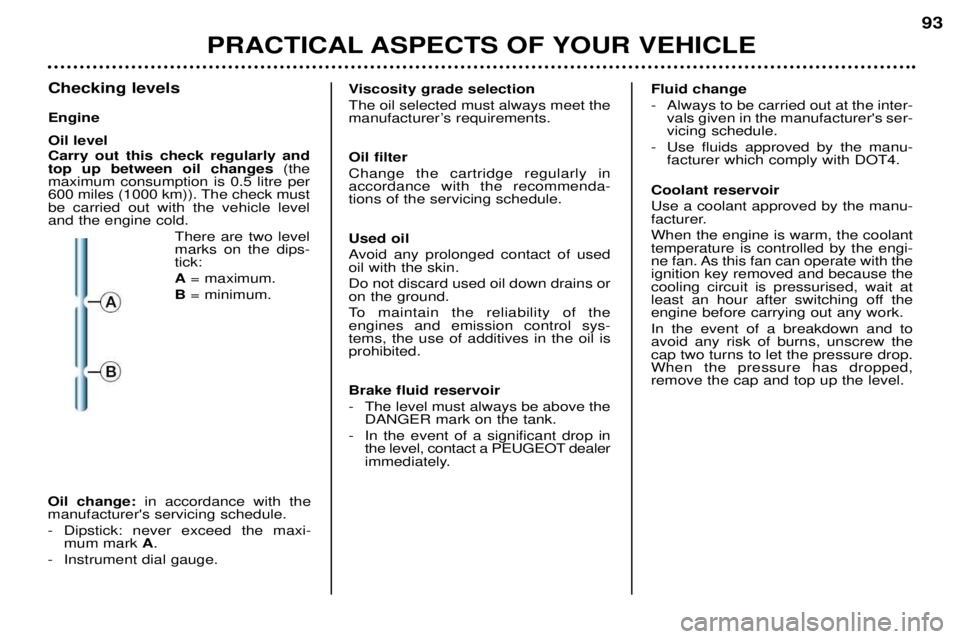Page 93 of 123
PRACTICAL ASPECTS OF YOUR VEHICLE91
1 -
Power steering reservoir
2 - Windscreen and headlamp wash reservoir*
3 - Coolant reservoir 4 -
Brake fluid reservoir
5 - Battery
6 - Air filter 7 -
Dipstick
8 - Engine oil reservoir
* According to specification.
1.6 LITRE 16V ENGINE
Page 94 of 123
PRACTICAL ASPECTS OF YOUR VEHICLE
92
1 -
Power steering reservoir
2 - Windscreen and headlamp wash reservoir*
3 - Coolant reservoir 4 -
Brake fluid reservoir
5 - Battery
6 - Air filter 7 -
Dipstick
8 - Engine oil reservoir
* According to specification.
2 LITRE 16 V ENGINE
Page 95 of 123

PRACTICAL ASPECTS OF YOUR VEHICLE93
Checking levels Engine Oil level Carry out this check regularly and top up between oil changes
(the
maximum consumption is 0.5 litre per
600 miles (1000 km)). The check mustbe carried out with the vehicle leveland the engine cold.
There are two levelmarks on the dips-tick: A= maximum.
B = minimum. Viscosity grade selectionThe oil selected must always meet the
manufacturerÕs requirements. Oil filter Change the cartridge regularly in accordance with the recommenda-tions of the servicing schedule. Used oil
Avoid any prolonged contact of used oil with the skin. Do not discard used oil down drains or on the ground.
To maintain the reliability of the engines and emission control sys-tems, the use of additives in the oil isprohibited. Brake fluid reservoir
- The level must always be above the
DANGER mark on the tank.
- In the event of a significant drop in the level, contact a PEUGEOT dealer
immediately. Fluid change
- Always to be carried out at the inter-
vals given in the manufacturer's ser- vicing schedule.
- Use fluids approved by the manu- facturer which comply with DOT4.
Coolant reservoir Use a coolant approved by the manu-
facturer. When the engine is warm, the coolant temperature is controlled by the engi-
ne fan. As this fan can operate with theignition key removed and because thecooling circuit is pressurised, wait at
least an hour after switching off theengine before carrying out any work. In the event of a breakdown and to avoid any risk of burns, unscrew thecap two turns to let the pressure drop.When the pressure has dropped,remove the cap and top up the level.
Oil change: in accordance with the
manufacturer's servicing schedule.
- Dipstick: never exceed the maxi- mum mark A.
- Instrument dial gauge.
Page 106 of 123
PRACTICAL ASPECTS OF YOUR VEHICLE103
Changing a fuse
The fuse boxes are located under the instrument panel and in the enginecompartment. Fascia fuse box Unscrew the catch a quarter turn using a coin, then remove the cover togain access to the fuses.Removing and refitting a fuse
Before changing a fuse, the cause of the fault must be found and remedied. The fuse numbers are indicated on the fuse box. Always replace a faulty fuse (fault registered depending on fuse) with a fuse of the same rating.
Correct
Incorrect
* According to specification.Fuse Rating Functions*
1 15A Heated seat - Alarm
4 20A Mulltifunction screen - Navigation control unit-
Boot lighting - Audiosystem - Retractableroof control unit
5 15A Automatic gearbox diagnostics
6 10A Coolant level - Auto- matic gearbox - Audio system
Page 107 of 123
PRACTICAL ASPECTS OF YOUR VEHICLE103
Changing a fuse
The fuse boxes are located under the instrument panel and in the enginecompartment. Fascia fuse box Unscrew the catch a quarter turn using a coin, then remove the cover togain access to the fuses.Removing and refitting a fuse
Before changing a fuse, the cause of the fault must be found and remedied. The fuse numbers are indicated on the fuse box. Always replace a faulty fuse (fault registered depending on fuse) with a fuse of the same rating.
Correct
Incorrect
* According to specification.Fuse Rating Functions*
1 15A Heated seat - Alarm
4 20A Mulltifunction screen - Navigation control unit-
Boot lighting - Audiosystem - Retractableroof control unit
5 15A Automatic gearbox diagnostics
6 10A Coolant level - Auto- matic gearbox - Audio system
Page 114 of 123

PRACTICAL ASPECTS OF YOUR VEHICLE
110
Towing a trailer, caravan, boat etc.
Only use original PEUGEOT tow bars that have been tested and approvedfrom the design stage of your vehicle.The tow bar must be fitted by a
PEUGEOT dealer.
Your vehicle is mainly designed for transporting people and luggage but it
may also be used for towing a trailer. Driving with a trailer subjects the tow- ing vehicle to more significant stressand its driver must be particularlycareful. Air density decreases with altitude, thus reducing engine performance.The maximum towing load must bereduced by 10% for every1000 metres of altitude. Driving advice Distribution of loadsDistribute the load in the trailer so that the heaviest items are as close aspossible to the axle and the noseweight approaches the maximum per-mitted without exceeding it. Cooling
Towing a trailer on a slope increases the temperature of the coolant. As the fan is electrically controlled, its cooling capacity is not dependent onthe engine speed.
On the contrary, use a high gear to lower the engine speed, and reduceyour speed. The maximum towing load on a long slope depends on the gradient and theoutside temperature. Always pay attention to the coolant temperature. If the warning light comes on, stop the
vehicle and switch off the engine assoon as possible.
Tyres Check the tyre pressures of the towing
vehicle and of the trailer, observing therecommended pressures.
Braking
Towing increases the braking dis- tance. Lights Adjust your headlamps so that they do not dazzle other road users.Check the electrical signalling on the
trailer. Side wind
Take into acount the increased sensi- tivity to side wind.